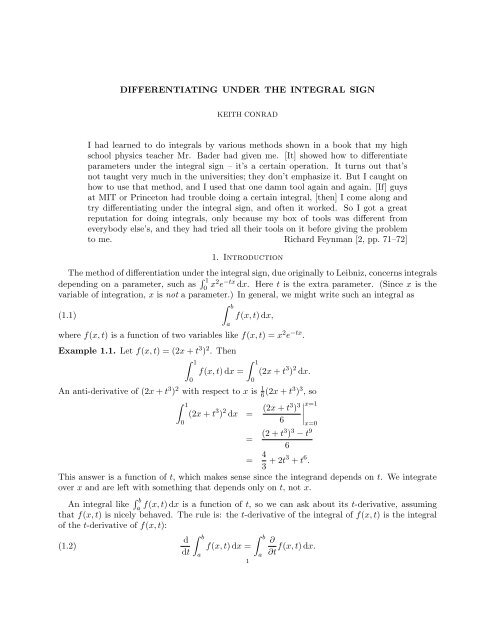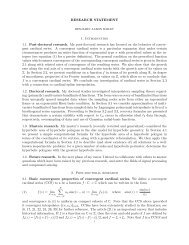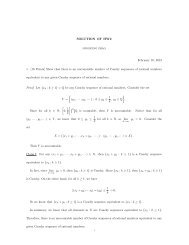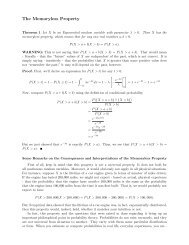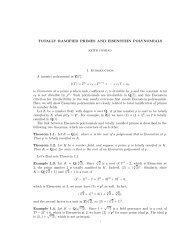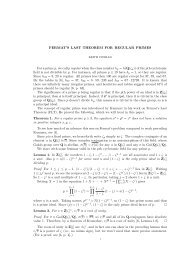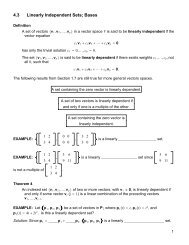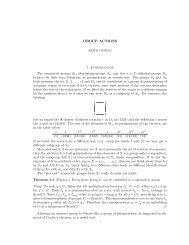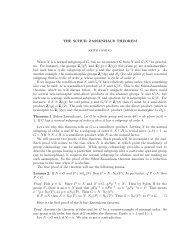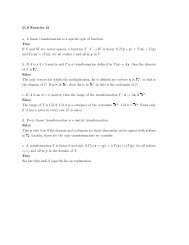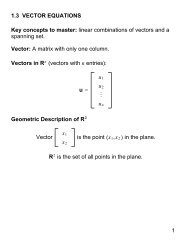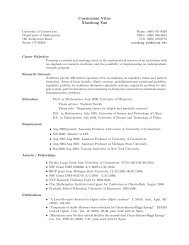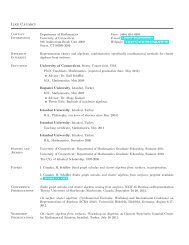Differentiation under the integral sign
Differentiation under the integral sign
Differentiation under the integral sign
Create successful ePaper yourself
Turn your PDF publications into a flip-book with our unique Google optimized e-Paper software.
DIFFERENTIATING UNDER THE INTEGRAL SIGN<br />
KEITH CONRAD<br />
I had learned to do <strong>integral</strong>s by various methods shown in a book that my high<br />
school physics teacher Mr. Bader had given me. [It] showed how to differentiate<br />
parameters <strong>under</strong> <strong>the</strong> <strong>integral</strong> <strong>sign</strong> – it’s a certain operation. It turns out that’s<br />
not taught very much in <strong>the</strong> universities; <strong>the</strong>y don’t emphasize it. But I caught on<br />
how to use that method, and I used that one damn tool again and again. [If] guys<br />
at MIT or Princeton had trouble doing a certain <strong>integral</strong>, [<strong>the</strong>n] I come along and<br />
try differentiating <strong>under</strong> <strong>the</strong> <strong>integral</strong> <strong>sign</strong>, and often it worked. So I got a great<br />
reputation for doing <strong>integral</strong>s, only because my box of tools was different from<br />
everybody else’s, and <strong>the</strong>y had tried all <strong>the</strong>ir tools on it before giving <strong>the</strong> problem<br />
to me. Richard Feynman [2, pp. 71–72]<br />
1. Introduction<br />
The method of differentiation <strong>under</strong> <strong>the</strong> <strong>integral</strong> <strong>sign</strong>, due originally to Leibniz, concerns <strong>integral</strong>s<br />
depending on a parameter, such as 1<br />
0 x2e−tx dx. Here t is <strong>the</strong> extra parameter. (Since x is <strong>the</strong><br />
variable of integration, x is not a parameter.) In general, we might write such an <strong>integral</strong> as<br />
b<br />
(1.1)<br />
f(x, t) dx,<br />
where f(x, t) is a function of two variables like f(x, t) = x 2 e −tx .<br />
Example 1.1. Let f(x, t) = (2x + t3 ) 2 . Then<br />
1<br />
1<br />
f(x, t) dx = (2x + t 3 ) 2 dx.<br />
0<br />
a<br />
An anti-derivative of (2x + t3 ) 2 with respect to x is 1<br />
6 (2x + t3 ) 3 , so<br />
1<br />
(2x + t<br />
0<br />
3 ) 2 dx = (2x + t3 ) 3<br />
x=1<br />
<br />
<br />
6 <br />
x=0<br />
= (2 + t3 ) 3 − t9 6<br />
= 4<br />
3 + 2t3 + t 6 .<br />
This answer is a function of t, which makes sense since <strong>the</strong> integrand depends on t. We integrate<br />
over x and are left with something that depends only on t, not x.<br />
An <strong>integral</strong> like b<br />
a f(x, t) dx is a function of t, so we can ask about its t-derivative, assuming<br />
that f(x, t) is nicely behaved. The rule is: <strong>the</strong> t-derivative of <strong>the</strong> <strong>integral</strong> of f(x, t) is <strong>the</strong> <strong>integral</strong><br />
of <strong>the</strong> t-derivative of f(x, t):<br />
b<br />
b<br />
d<br />
∂<br />
(1.2)<br />
f(x, t) dx = f(x, t) dx.<br />
dt<br />
∂t<br />
a<br />
1<br />
0<br />
a
2 KEITH CONRAD<br />
This is called differentiation <strong>under</strong> <strong>the</strong> <strong>integral</strong> <strong>sign</strong>. If you are used to thinking mostly about<br />
functions with one variable, not two, keep in mind that (1.2) involves <strong>integral</strong>s and derivatives with<br />
respect to separate variables: integration with respect to x and differentiation with respect to t.<br />
Example 1.2. We saw in Example 1.1 that 1<br />
0 (2x + t3 ) 2 dx = 4/3 + 2t3 + t6 , whose t-derivative is<br />
6t2 + 6t5 . According to (1.2), we can also compute <strong>the</strong> t-derivative of <strong>the</strong> <strong>integral</strong> like this:<br />
The answers agree.<br />
d<br />
dt<br />
1<br />
(2x + t 3 ) 2 dx =<br />
0<br />
=<br />
=<br />
1 ∂<br />
0 ∂t (2x + t3 ) 2 dx<br />
1<br />
2(2x + t 3 )(3t 2 ) dx<br />
0<br />
1<br />
(12t 2 x + 6t 5 ) dx<br />
0<br />
= 6t 2 x 2 + 6t 5 x x=1 x=0<br />
= 6t 2 + 6t 5 .<br />
2. Euler’s factorial <strong>integral</strong> in a new light<br />
For integers n ≥ 0, Euler’s <strong>integral</strong> formula for n! is<br />
∞<br />
(2.1)<br />
0<br />
x n e −x dx = n!,<br />
which can be obtained by repeated integration by parts starting from <strong>the</strong> formula<br />
∞<br />
(2.2)<br />
e −x dx = 1<br />
0<br />
when n = 0. Now we are going to derive Euler’s formula in ano<strong>the</strong>r way, by repeated differentiation<br />
after introducing a parameter t into (2.2).<br />
For any t > 0, let x = tu. Then dx = t du and (2.2) becomes<br />
∞<br />
te −tu du = 1.<br />
Dividing by t and writing u as x (why is this not a problem?), we get<br />
∞<br />
(2.3)<br />
e −tx dx = 1<br />
t .<br />
0<br />
0<br />
This is a parametric form of (2.2), where both sides are now functions of t. We need t > 0 in order<br />
that e −tx is integrable over <strong>the</strong> region x ≥ 0.<br />
Now we bring in differentiation <strong>under</strong> <strong>the</strong> <strong>integral</strong> <strong>sign</strong>. Differentiate both sides of (2.3) with<br />
respect to t, using (1.2) to treat <strong>the</strong> left side. We obtain<br />
so<br />
(2.4)<br />
∞<br />
0<br />
∞<br />
0<br />
−xe −tx dx = − 1<br />
,<br />
t2 xe −tx dx = 1<br />
.<br />
t2
DIFFERENTIATING UNDER THE INTEGRAL SIGN 3<br />
Differentiate both sides of (2.4) with respect to t, again using (1.2) to handle <strong>the</strong> left side. We get<br />
∞<br />
−x 2 e −tx dx = − 2<br />
.<br />
t3 Taking out <strong>the</strong> <strong>sign</strong> on both sides,<br />
(2.5)<br />
0<br />
∞<br />
0<br />
x 2 e −tx dx = 2<br />
.<br />
t3 If we continue to differentiate each new equation with respect to t a few more times, we obtain<br />
∞<br />
x<br />
0<br />
3 e −tx dx = 6<br />
,<br />
t4 ∞<br />
x<br />
0<br />
4 e −tx dx = 24<br />
,<br />
t5 and ∞<br />
x<br />
0<br />
5 e −tx dx = 120<br />
.<br />
t6 Do you see <strong>the</strong> pattern? It is<br />
∞<br />
(2.6)<br />
0<br />
x n e −tx dx = n!<br />
.<br />
tn+1 We have used <strong>the</strong> presence of <strong>the</strong> extra variable t to get <strong>the</strong>se equations by repeatedly applying<br />
d/dt. Now specialize t to 1 in (2.6). We obtain<br />
∞<br />
0<br />
x n e −x dx = n!,<br />
which is our old friend (2.1). Voilá!<br />
The idea that made this work is introducing a parameter t, using calculus on t, and <strong>the</strong>n setting<br />
t to a particular value so it disappears from <strong>the</strong> final formula. In o<strong>the</strong>r words, sometimes to solve<br />
a problem it is useful to solve a more general problem. Compare (2.1) to (2.6).<br />
3. A damped sine <strong>integral</strong><br />
We are going to use differentiation <strong>under</strong> <strong>the</strong> <strong>integral</strong> <strong>sign</strong> to prove<br />
∞<br />
−tx sin x π<br />
e dx = − arctan t<br />
x 2<br />
0<br />
for t > 0.<br />
Call this <strong>integral</strong> F (t) and set f(x, t) = e−tx (sin x)/x, so (∂/∂t)f(x, t) = −e−tx sin x. Then<br />
F ′ ∞<br />
(t) = − e −tx (sin x) dx.<br />
The integrand e−tx sin x, as a function of x, can be integrated by parts:<br />
<br />
e ax (a sin x − cos x)<br />
sin x dx =<br />
1 + a2 e ax .<br />
Applying this with a = −t and turning <strong>the</strong> indefinite <strong>integral</strong> into a definite <strong>integral</strong>,<br />
F ′ ∞<br />
(t) = − e −tx (t sin x + cos x)<br />
(sin x) dx =<br />
1 + t2 e −tx<br />
<br />
x=∞<br />
<br />
.<br />
0<br />
0<br />
x=0
4 KEITH CONRAD<br />
As x → ∞, t sin x + cos x oscillates a lot, but in a bounded way (since sin x and cos x are bounded<br />
functions), while <strong>the</strong> term e−tx decays exponentially to 0 since t > 0. So <strong>the</strong> value at x = ∞ is 0.<br />
Therefore<br />
F ′ ∞<br />
(t) = − e<br />
0<br />
−tx (sin x) dx = − 1<br />
.<br />
1 + t2 We know an explicit antiderivative of 1/(1 + t2 ), namely arctan t. Since F (t) has <strong>the</strong> same<br />
t-derivative as − arctan t, <strong>the</strong>y differ by a constant: for some number C,<br />
∞<br />
−tx sin x<br />
(3.1)<br />
e dx = − arctan t + C for t > 0.<br />
0 x<br />
We’ve computed <strong>the</strong> <strong>integral</strong>, up to an additive constant, without finding an antiderivative of<br />
e−tx (sin x)/x.<br />
To compute C in (3.1), let t → ∞ on both sides. Since |(sin x)/x| ≤ 1, <strong>the</strong> absolute value of<br />
<strong>the</strong> <strong>integral</strong> on <strong>the</strong> left is bounded from above by ∞<br />
0 e−tx dx = 1/t, so <strong>the</strong> <strong>integral</strong> on <strong>the</strong> left in<br />
(3.1) tends to 0 as t → ∞. Since arctan t → π/2 as t → ∞, equation (3.1) as t → ∞ becomes<br />
0 = − π<br />
2 + C, so C = π/2. Feeding this back into (3.1),<br />
∞<br />
−tx sin x π<br />
(3.2)<br />
e dx = − arctan t for t > 0.<br />
x 2<br />
0<br />
If we let t → 0 + in (3.2), this equation suggests that<br />
∞ sin x π<br />
(3.3)<br />
dx =<br />
0 x 2 ,<br />
which is true and it is important in <strong>sign</strong>al processing and Fourier analysis. It is a delicate matter to<br />
derive (3.3) from (3.2) since <strong>the</strong> <strong>integral</strong> in (3.3) is not absolutely convergent. Details are provided<br />
in an appendix.<br />
(4.1)<br />
The improper <strong>integral</strong> formula<br />
4. The Gaussian <strong>integral</strong><br />
0<br />
∞<br />
e −x2 √<br />
/2<br />
dx = 2π<br />
−∞<br />
1<br />
is fundamental to probability <strong>the</strong>ory and Fourier analysis. The function √2π e−x2 /2 is called a<br />
Gaussian, and (4.1) says <strong>the</strong> <strong>integral</strong> of <strong>the</strong> Gaussian over <strong>the</strong> whole real line is 1.<br />
The physicist Lord Kelvin (after whom <strong>the</strong> Kelvin temperature scale is named) once wrote (4.1)<br />
on <strong>the</strong> board in a class and said “A ma<strong>the</strong>matician is one to whom that [pointing at <strong>the</strong> formula] is<br />
as obvious as twice two makes four is to you.” We will prove (4.1) using differentiation <strong>under</strong> <strong>the</strong><br />
<strong>integral</strong> <strong>sign</strong>. The method will not make (4.1) as obvious as 2 · 2 = 4. If you take fur<strong>the</strong>r courses<br />
you may learn more natural derivations of (4.1) so that <strong>the</strong> result really does become obvious. For<br />
now, just try to follow <strong>the</strong> argument here step-by-step.<br />
We are going to aim not at (4.1), but at an equivalent formula over <strong>the</strong> range x ≥ 0:<br />
∞<br />
(4.2)<br />
e −x2 √<br />
/2 2π<br />
dx =<br />
2 =<br />
<br />
π<br />
2 .<br />
For t > 0, set<br />
t<br />
A(t) =<br />
0<br />
e −x2 2<br />
/2<br />
dx .<br />
We want to calculate A(∞) and <strong>the</strong>n take a square root.
Differentiating with respect to t,<br />
A ′ t<br />
(t) = 2<br />
Let x = ty, so<br />
DIFFERENTIATING UNDER THE INTEGRAL SIGN 5<br />
0<br />
A ′ (t) = 2e −t2 /2<br />
0<br />
e −x2 /2 dx · e −t 2 /2 = 2e −t 2 /2<br />
t<br />
0<br />
e −x2 /2 dx.<br />
1<br />
te −t2y2 1<br />
/2<br />
dy = 2te −(1+y2 )t2 /2<br />
dy.<br />
0<br />
The function <strong>under</strong> <strong>the</strong> <strong>integral</strong> <strong>sign</strong> is easily antidifferentiated with respect to t:<br />
A ′ 1<br />
(t) = − ∂ 2e<br />
∂t<br />
−(1+y2 )t2 /2<br />
1 + y2 dy = −2 d<br />
1 e<br />
dt<br />
−(1+y2 )t2 /2<br />
1 + y2 dy.<br />
Letting<br />
1 e<br />
B(t) =<br />
0<br />
−(1+x2 )t2 /2<br />
1 + x2 dx,<br />
we have A ′ (t) = −2B ′ (t) for all t > 0, so <strong>the</strong>re is a constant C such that<br />
(4.3) A(t) = −2B(t) + C<br />
for all t > 0. To find C, we let t → 0 + in (4.3). The left side tends to ( 0<br />
0 e−x2 dx) 2 = 0 while <strong>the</strong><br />
right side tends to −2 1<br />
0 dx/(1 + x2 ) + C = −π/2 + C. Thus C = π/2, so (4.3) becomes<br />
t<br />
0<br />
e −x2 2<br />
/2<br />
dx<br />
= π<br />
− 2<br />
2<br />
1<br />
0<br />
0<br />
0<br />
e −(1+x2 )t 2 /2<br />
1 + x 2<br />
Letting t → ∞ here, we get ( ∞<br />
0 e−x2 /2 dx) 2 = π/2, so ∞<br />
0 e−x2 /2 dx = π/2. That is (4.2).<br />
5. Higher moments of <strong>the</strong> Gaussian<br />
For every integer n ≥ 0 we want to compute a formula for<br />
∞<br />
(5.1)<br />
x n e −x2 /2<br />
dx.<br />
−∞<br />
(Integrals of <strong>the</strong> type xnf(x) dx for n = 0, 1, 2, . . . are called <strong>the</strong> moments of f(x), so (5.1) is <strong>the</strong><br />
n-th moment of <strong>the</strong> Gaussian.) When n is odd, (5.1) vanishes since xne−x2 /2 is an odd function.<br />
What if n = 0, 2, 4, . . . is even?<br />
The first case, n = 0, is <strong>the</strong> Gaussian <strong>integral</strong> (4.1):<br />
∞<br />
(5.2)<br />
e −x2 √<br />
/2<br />
dx = 2π.<br />
−∞<br />
To get formulas for (5.1) when n = 0, we follow <strong>the</strong> same strategy as our treatment of <strong>the</strong> factorial<br />
<strong>integral</strong> in Section 2: stick a t into <strong>the</strong> exponent of e −x2 /2 and <strong>the</strong>n differentiate repeatedly with<br />
respect to t.<br />
For t > 0, replacing x with √ tx in (5.2) gives<br />
∞<br />
(5.3)<br />
e<br />
−∞<br />
−tx2 /2<br />
dx =<br />
−<br />
−∞<br />
x2<br />
√ 2π<br />
√t .<br />
Differentiate both sides of (5.3) with respect to t, using differentiation <strong>under</strong> <strong>the</strong> <strong>integral</strong> <strong>sign</strong> on<br />
<strong>the</strong> left: ∞<br />
2 e−tx2 √<br />
/2 2π<br />
dx = − ,<br />
2t3/2 dx.
6 KEITH CONRAD<br />
so<br />
(5.4)<br />
∞<br />
x<br />
−∞<br />
2 e −tx2 /2<br />
dx =<br />
√<br />
2π<br />
.<br />
t3/2 Differentiate both sides of (5.4) with respect to t. After removing a common factor of −1/2 on<br />
both sides, we get<br />
∞<br />
(5.5)<br />
x 4 e −tx2 /2 3<br />
dx = √ 2π<br />
.<br />
t5/2 −∞<br />
Differentiating both sides of (5.5) with respect to t a few more times, we get<br />
∞<br />
x 6 e −tx2 /2 3 · 5<br />
dx = √ 2π<br />
t7/2 ,<br />
and<br />
Quite generally, when n is even<br />
∞<br />
−∞<br />
∞<br />
∞<br />
−∞<br />
−∞<br />
−∞<br />
x 8 e −tx2 /2 3 · 5 · 7<br />
dx = √ 2π<br />
t9/2 ,<br />
x 10 e −tx2 /2 3 · 5 · 7 · 9<br />
dx = √ 2π<br />
t11/2 .<br />
x n e −tx2 /2 1 · 3 · 5 · · · (n − 1)<br />
dx =<br />
tn/2 <br />
2π<br />
t ,<br />
where <strong>the</strong> numerator is <strong>the</strong> product of <strong>the</strong> positive odd integers from 1 to n − 1 (<strong>under</strong>stood to be<br />
<strong>the</strong> empty product 1 when n = 0).<br />
In particular, taking t = 1 we have computed (5.1):<br />
∞<br />
x n e −x2 √<br />
/2<br />
dx = 1 · 3 · 5 · · · (n − 1) 2π.<br />
−∞<br />
As an application of (5.4), we now compute ( 1<br />
0 x1/2e−x dx, where <strong>the</strong> notation ( 1<br />
2 )! and<br />
its definition are inspired by Euler’s <strong>integral</strong> formula (2.1) for n! when n is a nonnegative integer.<br />
Using <strong>the</strong> substitution u = x1/2 in ∞<br />
0 x1/2e−x dx, we have<br />
∞<br />
1<br />
! = x<br />
2<br />
0<br />
1/2 e −x dx<br />
∞<br />
= ue<br />
0<br />
−u2<br />
(2u) du<br />
=<br />
∞<br />
2 u<br />
0<br />
2 e −u2<br />
du<br />
=<br />
∞<br />
u 2 e −u2<br />
du<br />
=<br />
=<br />
−∞<br />
2 )! := ∞<br />
√<br />
2π<br />
by (5.4) at t = 2<br />
23/2 √<br />
π<br />
2 .
We are going to compute<br />
DIFFERENTIATING UNDER THE INTEGRAL SIGN 7<br />
6. A cosine transform of <strong>the</strong> Gaussian<br />
∞<br />
F (t) =<br />
0<br />
cos(tx)e −x2 /2 dx<br />
by looking at its t-derivative:<br />
(6.1) F ′ ∞<br />
(t) = −x sin(tx)e −x2 /2<br />
dx.<br />
0<br />
This is good from <strong>the</strong> viewpoint of integration by parts since −xe −x2 /2 is <strong>the</strong> derivative of e −x 2 /2 .<br />
So we apply integration by parts to (6.1):<br />
and<br />
Then<br />
u = sin(tx), dv = −xe −x2<br />
dx<br />
du = t cos(tx) dx, v = e −x2 /2 .<br />
F ′ ∞<br />
(t) = u dv<br />
=<br />
=<br />
0<br />
<br />
∞<br />
∞<br />
uv<br />
− v du<br />
0 0<br />
sin(tx)<br />
ex2 =<br />
<br />
x=∞<br />
∞<br />
<br />
/2 − t<br />
x=0 0<br />
sin(tx)<br />
ex2 <br />
x=∞<br />
<br />
/2 − tF (t).<br />
x=0<br />
cos(tx)e −x2 /2 dx<br />
As x → ∞, e x2 /2 blows up while sin(tx) stays bounded, so sin(tx)/e x 2 /2 goes to 0. Therefore<br />
F ′ (t) = −tF (t).<br />
We know <strong>the</strong> solutions to this differential equation: constant multiples of e−t2 /2 . So<br />
∞<br />
cos(tx)e −x2 /2 −t<br />
dx = Ce 2 /2<br />
0<br />
for some constant C. To find C, set t = 0. The left side is ∞<br />
0 e−x2 /2 dx, which is π/2 by (4.2).<br />
The right side is C. Thus C = π/2, so we are done: for all real t,<br />
∞<br />
cos(tx)e −x2 <br />
/2 π<br />
dx =<br />
2 e−t2 /2<br />
.<br />
0<br />
Remark 6.1. If we want to compute G(t) = ∞<br />
0 sin(tx)e −x2 /2 dx, with sin(tx) in place of cos(tx),<br />
<strong>the</strong>n in place of F ′ (t) = −tF (t) we have G ′ (t) = 1−tG(t), and G(0) = 0. From <strong>the</strong> differential equa-<br />
tion, (e t2 /2 G(t)) ′ = e t 2 /2 , so G(t) = e −t 2 /2 t<br />
0 ex2 /2 dx. So while ∞<br />
0 cos(tx)e−x2 /2 dx = π<br />
2 e−t2 /2 ,<br />
<strong>the</strong> <strong>integral</strong> ∞<br />
0 sin(tx)e −x2 /2 dx is impossible to express in terms of elementary functions.
8 KEITH CONRAD<br />
7. Logs in <strong>the</strong> denominator, part I<br />
Consider <strong>the</strong> following <strong>integral</strong> over [0, 1], where t > 0:<br />
1 xt − 1<br />
log x dx.<br />
0<br />
Since 1/ log x → 0 as x → 0 + , <strong>the</strong> integrand vanishes at x = 0. As x → 1− , (xt − 1)/ log x → 0.<br />
Therefore when t is fixed <strong>the</strong> integrand is a continuous function of x on [0, 1], so <strong>the</strong> <strong>integral</strong> is not<br />
an improper <strong>integral</strong>.<br />
The t-derivative of this <strong>integral</strong> is<br />
1<br />
0<br />
x t log x<br />
log x<br />
1<br />
dx =<br />
0<br />
x t dx = 1<br />
1 + t ,<br />
which we recognize as <strong>the</strong> t-derivative of log(1 + t). Therefore<br />
1 xt − 1<br />
dx = log(1 + t) + C.<br />
log x<br />
0<br />
To find C, let t → 0 + . On <strong>the</strong> right side <strong>the</strong> term log(1 + t) tends to 0. On <strong>the</strong> left side, <strong>the</strong><br />
integrand tends to 0: |(x t − 1)/ log x| = |(e t log x − 1)/ log x| ≤ t because |e a − 1| ≤ |a| when a ≤ 0.<br />
Therefore <strong>the</strong> <strong>integral</strong> on <strong>the</strong> left tends to 0. So C = 0, which implies<br />
for all t > 0. For example,<br />
1<br />
0<br />
x t − 1<br />
log x<br />
1<br />
0<br />
dx = log(1 + t)<br />
x − 1<br />
dx = log 2.<br />
log x<br />
We computed this definite <strong>integral</strong> without computing an anti-derivative of (x − 1)/ log x.<br />
We now consider <strong>the</strong> <strong>integral</strong><br />
8. Logs in <strong>the</strong> denominator, part II<br />
∞ dx<br />
F (t) =<br />
xt log x<br />
2<br />
for t > 1. The <strong>integral</strong> converges by comparison with ∞<br />
2 dx/xt . We know that “at t = 1” <strong>the</strong><br />
<strong>integral</strong> diverges to ∞:<br />
∞<br />
2<br />
dx<br />
x log x<br />
= lim<br />
b→∞<br />
b<br />
2<br />
dx<br />
x log x<br />
<br />
b<br />
= lim log log x<br />
b→∞ <br />
= lim<br />
b→∞ log log b − log log 2<br />
= ∞.<br />
So we expect that as t → 1 + , F (t) should blow up. But how does it blow up? By analyzing F ′ (t)<br />
and <strong>the</strong>n integrating back, we are going to show F (t) behaves essentially like − log(t−1) as t → 1 + .<br />
2
DIFFERENTIATING UNDER THE INTEGRAL SIGN 9<br />
Using differentiation <strong>under</strong> <strong>the</strong> <strong>integral</strong> <strong>sign</strong>, for t > 1<br />
F ′ ∞ <br />
∂ 1<br />
(t) =<br />
2 ∂t xt <br />
dx<br />
log x<br />
∞ x<br />
=<br />
2<br />
−t (− log x)<br />
dx<br />
log x<br />
∞ dx<br />
= −<br />
2 xt = − x−t+1<br />
x=∞<br />
<br />
<br />
−t + 1<br />
= 21−t<br />
1 − t .<br />
We want to bound this derivative from above and below when t > 1. Then we will integrate to get<br />
bounds on <strong>the</strong> size of F (t).<br />
For t > 1, <strong>the</strong> difference 1 − t is negative, so 2 1−t < 1. Dividing both sides of this by 1 − t, which<br />
is negative, reverses <strong>the</strong> sense of <strong>the</strong> inequality and gives<br />
21−t 1<br />
><br />
1 − t 1 − t .<br />
This is a lower bound on F ′ (t). To get an upper bound on F ′ (t), we want to use a lower bound<br />
on 21−t . Since ea ≥ a + 1 for all a (<strong>the</strong> graph of y = ex lies on or above its tangent line at x = 0,<br />
which is y = x + 1),<br />
2 x = e x log 2 ≥ (log 2)x + 1<br />
for all x. Taking x = 1 − t,<br />
x=2<br />
(8.1) 2 1−t ≥ (log 2)(1 − t) + 1.<br />
When t > 1, 1 − t is negative, so dividing (8.1) by 1 − t reverses <strong>the</strong> sense of <strong>the</strong> inequality:<br />
21−t 1<br />
≤ log 2 +<br />
t − 1 1 − t .<br />
This is an upper bound on F ′ (t). Putting <strong>the</strong> upper and lower bounds on F ′ (t) toge<strong>the</strong>r,<br />
1<br />
(8.2)<br />
1 − t < F ′ (t) ≤ log 2 + 1<br />
1 − t<br />
for all t > 1.<br />
We are concerned with <strong>the</strong> behavior of F (t) as t → 1 + . Let’s integrate (8.2) from a to 2, where<br />
1 < a < 2: 2 dt<br />
a 1 − t <<br />
2<br />
F<br />
a<br />
′ 2 <br />
(t) dt ≤ log 2 +<br />
a<br />
1<br />
<br />
dt.<br />
1 − t<br />
Using <strong>the</strong> Fundamental Theorem of Calculus,<br />
<br />
2<br />
<br />
2<br />
<br />
2<br />
− log(t − 1) <br />
< F (t) <br />
≤ ((log 2)t − log(t − 1)) <br />
,<br />
so<br />
a<br />
a<br />
log(a − 1) < F (2) − F (a) ≤ (log 2)(2 − a) + log(a − 1).<br />
Manipulating to get inequalities on F (a), we have<br />
(log 2)(a − 2) − log(a − 1) + F (2) ≤ F (a) < − log(a − 1) + F (2)<br />
a
10 KEITH CONRAD<br />
Since a − 2 > −1 for 1 < a < 2, (log 2)(a − 2) is greater than − log 2. This gives <strong>the</strong> bounds<br />
Writing a as t, we get<br />
− log(a − 1) + F (2) − log 2 ≤ F (a) < − log(a − 1) + F (2)<br />
− log(t − 1) + F (2) − log 2 ≤ F (t) < − log(t − 1) + F (2),<br />
so F (t) is a bounded distance from − log(t−1) when 1 < t < 2. In particular, F (t) → ∞ as t → 1 + .<br />
9. Smoothly dividing by t<br />
Let h(t) be an infinitely differentiable function for all real t such that h(0) = 0. The ratio h(t)/t<br />
makes sense for t = 0, and it also can be given a reasonable meaning at t = 0: from <strong>the</strong> very<br />
definition of <strong>the</strong> derivative, when t → 0 we have<br />
Therefore <strong>the</strong> function<br />
h(t)<br />
t<br />
r(t) =<br />
= h(t) − h(0)<br />
t − 0<br />
→ h′ (0).<br />
<br />
h(t)/t, if t = 0,<br />
h ′ (0), if t = 0<br />
is continuous for all t. We can see immediately from <strong>the</strong> definition of r(t) that it is better than<br />
continuous when t = 0: it is infinitely differentiable when t = 0. The question we want to address<br />
is this: is r(t) infinitely differentiable at t = 0 too?<br />
If h(t) has a power series representation around t = 0, <strong>the</strong>n it is easy to show that r(t) is infinitely<br />
differentiable at t = 0 by working with <strong>the</strong> series for h(t). Indeed, write<br />
h(t) = c1t + c2t 2 + c3t 3 + · · ·<br />
for all small t. Here c1 = h ′ (0), c2 = h ′′ (0)/2! and so on. For small t = 0, we divide by t and get<br />
(9.1) r(t) = c1 + c2t + c3t 3 + · · · ,<br />
which is a power series representation for r(t) for all small t = 0. The value of <strong>the</strong> right side of<br />
(9.1) at t = 0 is c1 = h ′ (0), which is also <strong>the</strong> defined value of r(0), so (9.1) is valid for all small x<br />
(including t = 0). Therefore r(t) has a power series representation around 0 (it’s just <strong>the</strong> power<br />
series for h(t) at 0 divided by t). Since functions with power series representations around a point<br />
are infinitely differentiable at <strong>the</strong> point, r(t) is infinitely differentiable at t = 0.<br />
However, this is an incomplete answer to our question about <strong>the</strong> infinite differentiability of r(t)<br />
at t = 0 because we know by <strong>the</strong> key example of e−1/t2 (at t = 0) that a function can be infinitely<br />
differentiable at a point without having a power series representation at <strong>the</strong> point. How are we<br />
going to show r(t) = h(t)/t is infinitely differentiable at t = 0 if we don’t have a power series to<br />
help us out? Might <strong>the</strong>re actually be a counterexample?<br />
The solution is to write h(t) in a very clever way using differentiation <strong>under</strong> <strong>the</strong> <strong>integral</strong> <strong>sign</strong>.<br />
Start with<br />
t<br />
h(t) = h ′ (u) du.<br />
0<br />
(This is correct since h(0) = 0.) For t = 0, introduce <strong>the</strong> change of variables u = tx, so du = t dx.<br />
At <strong>the</strong> boundary, if u = 0 <strong>the</strong>n x = 0. If u = t <strong>the</strong>n x = 1 (we can divide <strong>the</strong> equation t = tx by t<br />
because t = 0). Therefore<br />
1<br />
h(t) = h ′ 1<br />
(tx)t dx = t h ′ (tx) dx.<br />
0<br />
0
Dividing by t when t = 0, we get<br />
DIFFERENTIATING UNDER THE INTEGRAL SIGN 11<br />
r(t) = h(t)<br />
t =<br />
1<br />
h ′ (tx) dx.<br />
The left and right sides don’t have any t in <strong>the</strong> denominator. Are <strong>the</strong>y equal at t = 0 too? The<br />
left side at t = 0 is r(0) = h ′ (0). The right side is 1<br />
0 h′ (0) dx = h ′ (0) too, so<br />
1<br />
(9.2) r(t) = h ′ (tx) dx<br />
0<br />
for all t, including t = 0. This is a formula for h(t)/t where <strong>the</strong>re is no longer a t being divided!<br />
Now we’re set to use differentiation <strong>under</strong> <strong>the</strong> <strong>integral</strong> <strong>sign</strong>. The way we have set things up<br />
here, we want to differentiate with respect to t; <strong>the</strong> integration variable on <strong>the</strong> right is x. We can<br />
use differentiation <strong>under</strong> <strong>the</strong> <strong>integral</strong> <strong>sign</strong> on (9.2) when <strong>the</strong> integrand is differentiable. Since <strong>the</strong><br />
integrand is infinitely differentiable, r(t) is infinitely differentiable!<br />
Explicitly,<br />
r ′ 1<br />
(t) = vh ′′ (tx) dx<br />
and<br />
and more generally<br />
0<br />
r ′′ 1<br />
(t) = vh ′′ (tx) dx<br />
0<br />
r (k) 1<br />
(t) = x k h (k+1) (tx) dx.<br />
In particular, r (k) (0) = 1<br />
0 xk h (k+1) (0) dx = h(k+1) (0)<br />
k+1 .<br />
0<br />
10. Counterexamples<br />
We have seen many examples where differentiation <strong>under</strong> <strong>the</strong> <strong>integral</strong> <strong>sign</strong> can be carried out<br />
with interesting results, but we have not actually stated conditions <strong>under</strong> which (1.2) is valid.<br />
Something does need to be checked. In [6], an incorrect use of differentiation <strong>under</strong> <strong>the</strong> <strong>integral</strong><br />
<strong>sign</strong> due to Cauchy is discussed, where a divergent <strong>integral</strong> is evaluated as a finite expression. Here<br />
are two o<strong>the</strong>r examples where differentiation <strong>under</strong> <strong>the</strong> <strong>integral</strong> <strong>sign</strong> does not work.<br />
Example 10.1. It is pointed out in [3] that <strong>the</strong> formula<br />
∞ sin x π<br />
dx =<br />
x 2 ,<br />
which we discussed at <strong>the</strong> end of Section 3, can be rewritten as<br />
∞ sin(ty)<br />
(10.1)<br />
dy =<br />
y<br />
π<br />
2 ,<br />
0<br />
0<br />
for any t > 0, by <strong>the</strong> change of variables x = ty. Then differentiation <strong>under</strong> <strong>the</strong> <strong>integral</strong> <strong>sign</strong> implies<br />
∞<br />
cos(ty) dy = 0,<br />
which doesn’t make sense.<br />
0<br />
The next example shows that even if both sides of (1.2) make sense, <strong>the</strong>y need not be equal.<br />
0
12 KEITH CONRAD<br />
Example 10.2. For any real numbers x and t, let<br />
⎧<br />
⎨ xt<br />
f(x, t) =<br />
⎩<br />
3<br />
(x2 + t2 , if x = 0 or t = 0,<br />
) 2<br />
0, if x = 0 and t = 0.<br />
Let<br />
1<br />
F (t) = f(x, t) dx.<br />
For instance, F (0) = 1<br />
0 f(x, 0) dx = 1<br />
0 0 dx = 0. When t = 0,<br />
1 xt<br />
F (t) =<br />
0<br />
3<br />
(x2 + t2 dx<br />
) 2<br />
1+t2 =<br />
t2 t3 2u2 du (where u = x2 + t 2 )<br />
= − t3<br />
u=1+t<br />
<br />
<br />
2u<br />
2<br />
u=t2 t3 = −<br />
2(1 + t2 )<br />
t<br />
=<br />
2(1 + t2 ) .<br />
0<br />
+ t3<br />
2t 2<br />
This formula also works at t = 0, so F (t) = t/(2(1 + t2 )) for all t. Therefore F (t) is differentiable<br />
and<br />
F ′ 1 − t2<br />
(t) =<br />
2(1 + t2 ) 2<br />
for all t. In particular, F ′ (0) = 1<br />
2 .<br />
Now we compute ∂<br />
∂t f(x, t) and <strong>the</strong>n 1<br />
0<br />
tiable in t and ∂<br />
∂t<br />
∂<br />
∂t<br />
f(x, t) dx. Since f(0, t) = 0 for all t, f(0, t) is differen-<br />
f(0, t) = 0. For x = 0, f(x, t) is differentiable in t and<br />
Combining both cases (x = 0 and x = 0),<br />
(10.2)<br />
∂<br />
∂t f(x, t) = (x2 + t2 ) 2 (3xt2 ) − xt3 · 2(x2 + t2 )2t<br />
(x2 + t2 ) 4<br />
= xt2 (x 2 + t 2 )(3(x 2 + t 2 ) − 4t 2 )<br />
(x 2 + t 2 ) 4<br />
= xt2 (3x 2 − t 2 )<br />
(x 2 + t 2 ) 3 .<br />
∂<br />
f(x, t) =<br />
∂t<br />
is F ′ (0) = 1/2 and <strong>the</strong> right side is 1<br />
0<br />
∂<br />
∂t<br />
xt 2 (3x 2 −t 2 )<br />
(x 2 +t 2 ) 3 , if x = 0,<br />
0, if x = 0.<br />
In particular ∂<br />
<br />
<br />
∂t f(x, t) = 0. Therefore at t = 0 <strong>the</strong> left side of <strong>the</strong> “formula”<br />
t=0<br />
1<br />
1<br />
d<br />
∂<br />
f(x, t) dx = f(x, t) dx.<br />
dt 0<br />
0 ∂t<br />
<br />
f(x, t) dx = 0. The two sides are unequal!<br />
t=0
DIFFERENTIATING UNDER THE INTEGRAL SIGN 13<br />
The problem in this example is that ∂<br />
∂t f(x, t) is not a continuous function of (x, t). Indeed, <strong>the</strong><br />
denominator in <strong>the</strong> formula in (10.2) is (x2 + t2 ) 3 , which has a problem near (0, 0). Specifically,<br />
while this derivative vanishes at (0, 0), it we let (x, t) → (0, 0) along <strong>the</strong> line x = t, <strong>the</strong>n on this<br />
f(x, t) has <strong>the</strong> value 1/(4x), which does not tend to 0 as (x, t) → (0, 0).<br />
line ∂<br />
∂t<br />
Theorem 10.3. The two sides of (1.2) both exist and are equal at a point t = t0 provided <strong>the</strong><br />
following two conditions hold:<br />
• f(x, t) and ∂<br />
∂t f(x, t) are continuous functions of two variables when x is in <strong>the</strong> range of<br />
integration and t is in some interval around t0,<br />
• <strong>the</strong>re are upper bounds |f(x, t)| ≤ A(x) and | ∂<br />
∂t f(x, t)| ≤ B(x), both being independent of t,<br />
such that b<br />
a A(x) dx and b<br />
a B(x) dx converge.<br />
Proof. See [4, pp. 337–339]. <br />
In Table 1 we include choices for A(x) and B(x) for each of <strong>the</strong> functions we have treated. Since<br />
<strong>the</strong> calculation of a derivative at a point only depends on an interval around <strong>the</strong> point, we have<br />
replaced a t-range such as t > 0 with t ≥ c > 0 in some cases to obtain choices for A(x) and B(x).<br />
Section f(x, t) x range t range t we want A(x) B(x)<br />
2 xne−tx [0, ∞) t ≥ c > 0 1 xne−cx xn+1e−cx 3 e−tx sin x<br />
x (0, ∞) t ≥ c > 0 0 e−cx e−cx 4 e−t2 (1+x 2 )<br />
1+x2 [0, 1] 0 ≤ t ≤ c t → ∞ 1<br />
1+x2 5 x<br />
2c<br />
ne−tx2 R t ≥ c > 0 1 xne−cx2 xn+2e−cx2 6 cos(tx)e−x2 /2 [0, ∞) R all t e−x2 /2 |x|e−x2 /2<br />
7<br />
xt−1 log x (0, 1] 0 < t < c 1 1−xc 8<br />
log x<br />
1<br />
1<br />
xt 1<br />
log x [2, ∞) t ≥ c > 1 t > 1 x2 log x<br />
9 x k h (k+1) (tx) [0, 1] |t| < c 0 max<br />
|y|≤c |h(k+1) (y)| max<br />
|y|≤c |h(k+2) (y)|<br />
Table 1. Summary<br />
A version of differentiation <strong>under</strong> <strong>the</strong> <strong>integral</strong> <strong>sign</strong> for t a complex variable is in [5, pp. 392–393].<br />
11. An example needing a change of variables<br />
Our next example is taken from [1, pp. 78,84]. For all t ∈ R, we will show by differentiation<br />
<strong>under</strong> <strong>the</strong> <strong>integral</strong> <strong>sign</strong> that<br />
<br />
cos(xt)<br />
(11.1)<br />
1 + x2 dx = πe−|t| .<br />
R<br />
Here f(x, t) = cos(xt)/(1 + x2 ). Since f(x, t) is continuous and |f(x, t)| ≤ 1/(1 + x2 ), <strong>the</strong> <strong>integral</strong><br />
exists for all t. The function πe−|t| is not differentiable at t = 0, so we shouldn’t expect to be able<br />
to prove (11.1) at t = 0 using differentiation <strong>under</strong> <strong>the</strong> <strong>integral</strong> <strong>sign</strong>; this special case can be treated<br />
with elementary calculus:<br />
<br />
<br />
dx<br />
∞<br />
= arctan x<br />
1 + x2 = π.<br />
R<br />
−∞<br />
1<br />
x c
14 KEITH CONRAD<br />
The <strong>integral</strong> in (11.1) is an even function of t, so to compute it for t = 0 it suffices to treat <strong>the</strong> case<br />
t > 0. 1<br />
Let<br />
R<br />
<br />
F (t) =<br />
R<br />
cos(xt)<br />
dx.<br />
1 + x2 If we try to compute F ′ (t) for t > 0 using differentiation <strong>under</strong> <strong>the</strong> <strong>integral</strong> <strong>sign</strong>, we get<br />
(11.2) F ′ (t) ? <br />
=<br />
<br />
∂ cos(xt)<br />
∂t 1 + x2 <br />
dx = −<br />
x sin(xt)<br />
dx.<br />
1 + x2 Unfortunately, <strong>the</strong>re is no upper bound | ∂<br />
∂t f(x, t)| ≤ B(x) that justifies differentiating F (t) <strong>under</strong><br />
<strong>the</strong> <strong>integral</strong> <strong>sign</strong> (or even justifies that F (t) is differentiable). Indeed, when x is near a large odd<br />
multiple of (π/2)/t, <strong>the</strong> integrand in (11.2) has values that are approximately x/(1 + x2 ) ≈ 1/x,<br />
which is not integrable for large x. That does not mean (11.2) is actually false, although if we<br />
weren’t already told <strong>the</strong> answer on <strong>the</strong> right side of (11.1) <strong>the</strong>n we might be suspicious about<br />
whe<strong>the</strong>r <strong>the</strong> <strong>integral</strong> is differentiable for all t > 0; after all, you can’t easily tell from <strong>the</strong> <strong>integral</strong><br />
that it is not differentiable at t = 0.<br />
Having already raised suspicions about (11.2), we can get something really crazy if we differentiate<br />
<strong>under</strong> <strong>the</strong> <strong>integral</strong> <strong>sign</strong> a second time:<br />
F ′′ (t) ? <br />
x<br />
= −<br />
2 cos(xt)<br />
dx.<br />
1 + x2 If this made sense <strong>the</strong>n<br />
(11.3) F ′′ <br />
(t) − F (t) = −<br />
R<br />
R<br />
(x 2 + 1) cos(xt)<br />
1 + x 2<br />
R<br />
R<br />
<br />
dx = − cos(xt) dx =???.<br />
R<br />
All is not lost! Let’s make a change of variables. Fixing t > 0, set y = xt, so dy = t dx and<br />
<br />
F (t) =<br />
cos y<br />
1 + y2 /t2 dy<br />
t =<br />
<br />
t cos y<br />
t2 dy.<br />
+ y2 This new <strong>integral</strong> will be accessible to differentiation <strong>under</strong> <strong>the</strong> <strong>integral</strong> <strong>sign</strong>. (Although <strong>the</strong> new<br />
<strong>integral</strong> is an odd function of t while F (t) is an even function of t, <strong>the</strong>re is no contradiction because<br />
this new <strong>integral</strong> was derived only for t > 0.)<br />
Fix c ′ > c > 0. For t ∈ (c, c ′ ), <strong>the</strong> integrand in<br />
<br />
R<br />
t cos y<br />
t2 dy<br />
+ y2 is bounded above in absolute value by t/(t 2 + y 2 ) ≤ c ′ /(c 2 + y 2 ), which is independent of t and<br />
integrable over R. The t-partial derivative of <strong>the</strong> integrand is (y 2 − t 2 )(cos y)/(t 2 + y 2 ) 2 , which<br />
is bounded above in absolute value by (y 2 + t 2 )/(t 2 + y 2 ) 2 = 1/(t 2 + y 2 ) ≤ 1/(c 2 + y 2 ), which is<br />
independent of t and integrable over R. This justifies <strong>the</strong> use differentiation <strong>under</strong> <strong>the</strong> <strong>integral</strong> <strong>sign</strong><br />
according to Theorem 10.3: for c < t < c ′ , and hence for all t > 0 since we never specified c or c ′ ,<br />
F ′ <br />
(t) =<br />
R<br />
∂<br />
∂t<br />
t cos y<br />
t 2 + y 2<br />
<br />
dy =<br />
R<br />
R<br />
y2 − t2 (t2 + y2 cos y dy.<br />
) 2<br />
1 A reader who knows complex analysis can derive (11.1) for t > 0 by <strong>the</strong> residue <strong>the</strong>orem, viewing cos(xt) as <strong>the</strong><br />
real part of e ixt .
DIFFERENTIATING UNDER THE INTEGRAL SIGN 15<br />
We want to compute F ′′ (t) using differentiation <strong>under</strong> <strong>the</strong> <strong>integral</strong> <strong>sign</strong>. For 0 < c < t < c ′ , <strong>the</strong><br />
t-partial derivative of <strong>the</strong> integrand for F ′ (t) is bounded above in absolute value by a function of<br />
y that is independent of t and integrable over R (exercise), so for all t > 0 we have<br />
F ′′ <br />
(t) =<br />
∂2 ∂t2 <br />
t cos y<br />
t2 + y2 <br />
dy =<br />
∂2 ∂t2 <br />
t<br />
t2 + y2 <br />
cos y dy.<br />
R<br />
It turns out that (∂2 /∂t2 )(t/(t2 + y2 )) = −(∂2 /∂y2 )(t/(t2 + y2 )), so<br />
F ′′ <br />
∂<br />
(t) = −<br />
2<br />
∂y2 <br />
t<br />
t2 + y2 <br />
cos y dy.<br />
R<br />
R<br />
Using integration by parts on this formula for F ′′ (t) twice (starting with u = − cos y and dv =<br />
(∂2 /∂y2 )(t/(t2 + y2 )), we obtain<br />
F ′′ <br />
∂ t<br />
(t) = −<br />
∂y t2 + y2 <br />
t<br />
sin y dy =<br />
R t2 + y2 <br />
cos y dy = F (t).<br />
The equation F ′′ (t) = F (t) is a second order linear ODE whose general solution is ae t + be −t , so<br />
(11.4)<br />
<br />
R<br />
R<br />
cos(xt)<br />
1 + x 2 dx = aet + be −t<br />
for all t > 0 and some real constants a and b. To determine a and b we look at <strong>the</strong> behavior of <strong>the</strong><br />
<strong>integral</strong> in (11.4) as t → 0 + and as t → ∞.<br />
As t → 0 + , <strong>the</strong> integrand in (11.4) tends pointwise to 1/(1 + x2 ), so we expect <strong>the</strong> <strong>integral</strong> tends<br />
to <br />
R dx/(1 + x2 ) = π as t → 0 + . To justify this, we will bound <strong>the</strong> absolute value of <strong>the</strong> difference<br />
<br />
<br />
<br />
<br />
R<br />
cos(xt)<br />
dx −<br />
1 + x2 <br />
R<br />
dx<br />
1 + x2 <br />
<br />
<br />
≤<br />
<br />
|x|≤N<br />
R<br />
| cos(xt) − 1|<br />
1 + x 2<br />
by an expression that is arbitrarily small as t → 0 + . For any N > 0, break up <strong>the</strong> <strong>integral</strong> over R<br />
into <strong>the</strong> regions |x| ≤ N and |x| ≥ N. We have<br />
<br />
| cos(xt) − 1|<br />
R 1 + x2 <br />
| cos(xt) − 1|<br />
dx ≤<br />
|x|≤N 1 + x2 <br />
2<br />
dx +<br />
dx<br />
|x|≥N 1 + x2 <br />
<br />
t|x|<br />
2<br />
≤<br />
dx +<br />
dx<br />
|x|≤N 1 + x2 |x|≥N 1 + x2 <br />
|x|<br />
<br />
π<br />
<br />
= t<br />
dx + 4 − arctan N .<br />
1 + x2 2<br />
Taking N sufficiently large, we can make π/2 − arctan N as small as we wish, and after doing that<br />
we can make <strong>the</strong> first term as small as we wish by taking t sufficiently small. Returning to (11.4),<br />
letting t → 0 + we obtain π = a + b, so<br />
(11.5)<br />
<br />
R<br />
cos(xt)<br />
1 + x 2 dx = aet + (π − a)e −t<br />
for all t > 0.<br />
Now let t → ∞ in (11.5). The <strong>integral</strong> tends to 0 by <strong>the</strong> Riemann–Lebesgue lemma from Fourier<br />
analysis, although we can explain this concretely in our special case: using integration by parts<br />
with u = 1/(1 + x2 ) and dv = cos(xt) dx, we get<br />
<br />
R<br />
cos(xt) 1<br />
dx =<br />
1 + x2 t<br />
<br />
R<br />
2x sin(xt)<br />
(1 + x2 dx.<br />
) 2<br />
dx
16 KEITH CONRAD<br />
The absolute value of <strong>the</strong> term on <strong>the</strong> right is bounded above by a constant divided by t, which<br />
tends to 0 as t → ∞. Therefore ae t + (π − a)e −t → 0 as t → ∞. This forces a = 0, which completes<br />
<strong>the</strong> proof that F (t) = πe −t for t > 0.<br />
12. Exercises<br />
∞<br />
−tx sin x π<br />
1. From <strong>the</strong> formula e dx = − arctan t for t > 0, in Section 3, use a change<br />
0 x 2<br />
∞<br />
−ax sin(bx)<br />
of variables to obtain a formula for e dx when a and b are positive. Then use<br />
0 x<br />
∞<br />
differentiation <strong>under</strong> <strong>the</strong> <strong>integral</strong> <strong>sign</strong> with respect to b to find a formula for e −ax cos(bx) dx<br />
when a and b are positive. (<strong>Differentiation</strong> <strong>under</strong> <strong>the</strong> <strong>integral</strong> <strong>sign</strong> with respect to a will produce<br />
∞<br />
a formula for e<br />
0<br />
−ax sin(bx) dx, but that would be circular in our approach since we used that<br />
∞<br />
−tx sin x<br />
<strong>integral</strong> in our derivation of <strong>the</strong> formula for e<br />
0 x dx.)<br />
∞<br />
−tx sin x π<br />
2. From <strong>the</strong> formula e dx = − arctan t for t > 0, <strong>the</strong> change of variables x = ay<br />
0 x 2<br />
with a > 0 implies<br />
∞<br />
−tay sin(ay)<br />
e dy =<br />
0 y<br />
π<br />
− arctan t,<br />
2<br />
so <strong>the</strong> <strong>integral</strong> on <strong>the</strong> left is independent of a and thus has a-derivative 0. <strong>Differentiation</strong> <strong>under</strong><br />
<strong>the</strong> <strong>integral</strong> <strong>sign</strong>, with respect to a, implies<br />
∞<br />
e −tay (cos(ay) − t sin(ay)) dy = 0.<br />
0<br />
Verify that this application of differentiation <strong>under</strong> <strong>the</strong> <strong>integral</strong> <strong>sign</strong> is valid when a > 0 and t > 0.<br />
What happens if t = 0?<br />
∞<br />
<br />
−tx cos x − 1<br />
t<br />
3. Prove for t > 0 that e dx = log √ . What happens to <strong>the</strong> <strong>integral</strong><br />
0 x<br />
1 + t2 as t → 0 + ?<br />
4. In calculus textbooks, formulas for <strong>the</strong> indefinite <strong>integral</strong>s<br />
<br />
x n <br />
sin x dx and x n cos x dx<br />
are derived recursively using integration by parts. Find formulas for <strong>the</strong>se <strong>integral</strong>s when n =<br />
1, 2, 3, 4 using differentiation <strong>under</strong> <strong>the</strong> <strong>integral</strong> <strong>sign</strong> starting with <strong>the</strong> formulas<br />
<br />
cos(tx) dx = sin(tx)<br />
,<br />
t<br />
<br />
sin(tx) dx = − cos(tx)<br />
t<br />
for t > 0.<br />
5. If you are familiar with integration of complex-valued functions, show<br />
∞<br />
e −(x+iy)2<br />
dx = √ 2π<br />
−∞<br />
0
DIFFERENTIATING UNDER THE INTEGRAL SIGN 17<br />
for all y ∈ R. In o<strong>the</strong>r words, show <strong>the</strong> <strong>integral</strong> on <strong>the</strong> left side is independent of y. (Hint: Use<br />
differentiation <strong>under</strong> <strong>the</strong> <strong>integral</strong> <strong>sign</strong> to compute <strong>the</strong> y-derivative of <strong>the</strong> left side.)<br />
Appendix A. Justifying passage to <strong>the</strong> limit in a sine <strong>integral</strong><br />
In Section 3 we derived <strong>the</strong> equation<br />
∞<br />
−tx sin x π<br />
(A.1)<br />
e dx = − arctan t for t > 0,<br />
x 2<br />
0<br />
which by naive passage to <strong>the</strong> limit as t → 0 + suggests that<br />
∞ sin x π<br />
(A.2)<br />
dx =<br />
x 2 .<br />
0<br />
0<br />
0<br />
To prove (A.2) is correct, we will show ∞ sin x<br />
0 x dx exists and <strong>the</strong>n show <strong>the</strong> difference<br />
∞ ∞<br />
∞<br />
sin x<br />
−tx sin x<br />
(A.3)<br />
dx − e dx = (1 − e<br />
x x −tx sin x<br />
)<br />
x dx<br />
tends to 0 as t → 0 + . The key in both cases is alternating series.<br />
On <strong>the</strong> interval [kπ, (k + 1)π], where k is an integer, we can write sin x = (−1) k | sin x|, so<br />
convergence of ∞<br />
<br />
sin x<br />
b sin x<br />
0 x dx = limb→∞ 0 x dx is equivalent to convergence of <strong>the</strong> series<br />
<br />
(k+1)π sin x <br />
dx = (−1)<br />
x k<br />
(k+1)π | sin x|<br />
dx.<br />
x<br />
k≥0<br />
kπ<br />
This is an alternating series in which <strong>the</strong> terms ak = (k+1)π | sin x|<br />
kπ x<br />
(k+2)π<br />
ak+1 =<br />
(k+1)π<br />
| sin x|<br />
x<br />
(k+1)π<br />
dx =<br />
kπ<br />
k≥0<br />
0<br />
kπ<br />
| sin(x + π)|<br />
x + π<br />
By a simple estimate ak ≤ 1<br />
kπ for k ≥ 1, so ak → 0. Thus ∞<br />
dx are monotonically decreasing:<br />
(k+1)π | sin x|<br />
dx =<br />
dx < ak.<br />
x + π<br />
0<br />
sin x<br />
x<br />
kπ<br />
dx = <br />
k≥0 (−1)k ak converges.<br />
To show <strong>the</strong> right side of (A.3) tends to 0 as t → 0 + , we write it as an alternating series. Breaking<br />
up <strong>the</strong> interval of integration [0, ∞) into a union of intervals [kπ, (k + 1)π] for k ≥ 0,<br />
∞<br />
(A.4) (1 − e<br />
0<br />
−tx sin x <br />
) dx = (−1)<br />
x<br />
k≥0<br />
k (k+1)π<br />
Ik(t), where Ik(t) = (1 − e<br />
kπ<br />
−tx | sin x|<br />
) dx.<br />
x<br />
Since 1 − e−tx > 0 for t > 0 and x > 0, <strong>the</strong> series <br />
k≥0 (−1)kIk(t) is alternating. The upper bound<br />
1 − e−tx < 1 tells us Ik(t) ≤ 1<br />
kπ for k ≥ 1, so Ik(t) → 0 as k → ∞. To show <strong>the</strong> terms Ik(t) are<br />
monotonically decreasing with k, set this up as <strong>the</strong> inequality<br />
(A.5) Ik(t) − Ik+1(t) > 0 for t > 0.<br />
Each Ik(t) is a function of t for all t, not just t > 0 (note Ik(t) only involves integration on a<br />
bounded interval). The difference Ik(t) − Ik+1(t) vanishes when t = 0 (in fact both terms are <strong>the</strong>n<br />
0), and I ′ k (t) = (k+1)π<br />
kπ e−tx | sin x| dx for all t by differentiation <strong>under</strong> <strong>the</strong> <strong>integral</strong> <strong>sign</strong>, so (A.5)<br />
would follow from <strong>the</strong> derivative inequality I ′ k (t) − I′ k+1 (t) > 0 for t > 0. By a change of variables<br />
y = x − π in <strong>the</strong> <strong>integral</strong> for I ′ k+1 (t),<br />
(k+1)π<br />
(k+1)π<br />
I ′ k+1 (t) =<br />
kπ<br />
e −t(y+π) | sin(y + π)| dy = e −tπ<br />
kπ<br />
e −ty | sin y| dy < I ′ k (t).<br />
This completes <strong>the</strong> proof that <strong>the</strong> series in (A.4) for t > 0 satisfies <strong>the</strong> alternating series test.
18 KEITH CONRAD<br />
If we truncate <strong>the</strong> series <br />
k≥0 (−1)kIk(t) after <strong>the</strong> Nth term, <strong>the</strong> magnitude of <strong>the</strong> error is no<br />
greater than <strong>the</strong> absolute value of <strong>the</strong> next term:<br />
k=0<br />
<br />
(−1) k Ik(t) =<br />
k≥0<br />
0<br />
N<br />
(−1) k Ik(t) + rN, |rN| ≤ |IN+1(t)| ≤<br />
k=0<br />
1<br />
(N + 1)π .<br />
Since |1 − e−tx | ≤ tx,<br />
<br />
N<br />
<br />
(−1)<br />
<br />
k <br />
<br />
<br />
Ik(t) <br />
≤<br />
(N+1)π<br />
(1 − e −tx (N+1)π<br />
| sin x|<br />
) dx = t dx = t(N + 1)π.<br />
x<br />
0<br />
Thus ∞<br />
(1 − e<br />
0<br />
−tx sin x<br />
)<br />
x dx<br />
<br />
<br />
<br />
1<br />
≤ t(N + 1)π +<br />
(N + 1)π .<br />
For any ε > 0 we can make <strong>the</strong> second term at most ε/2 by a suitable choice of N. Then <strong>the</strong> first<br />
term is at most ε/2 for all small enough t (depending on N), and that shows (A.3) tends to 0 as<br />
t → 0 + .<br />
References<br />
[1] W. Appel, Ma<strong>the</strong>matics for Physics and Physicists, Princeton Univ. Press, Princeton, 2007.<br />
[2] R. P. Feynman, Surely You’re Joking, Mr. Feynman!, Bantam, New York, 1985.<br />
[3] S. K. Goel and A. J. Zajta, “Parametric Integration Techniques”, Math. Mag. 62 (1989), 318–322.<br />
[4] S. Lang, Undergraduate Analysis, 2nd ed., Springer-Verlag, New York, 1997.<br />
[5] S. Lang, Complex Analysis, 3rd ed., Springer-Verlag, New York, 1993.<br />
[6] E. Talvila, “Some Divergent Trigonometric Integrals”, Amer. Math. Monthly 108 (2001), 432–436.


